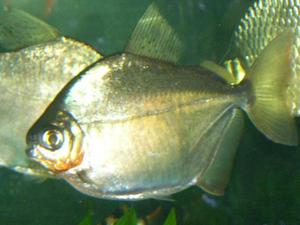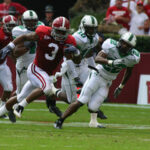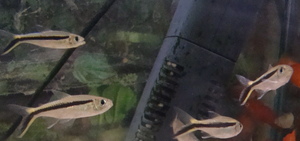Silver dollars are a very popular freshwater tropical fish. These fish are closely related to tetras and get their name from their scaleless silver sides and round shape. Though silver dollars are quite hardy and easy-going, they can be somewhat challenging to care for properly without extensive research ahead of time. Bear in mind that there are several species of silver dollar; this article applies to most of them, but size and space requirements as well as other recommendations have been tailored for the Metynnis argenteus, the fish commonly sold in pet stores as a silver dollar.
One of the primary challenges of silver dollars comes from their size. While these fish are docile they, like most fish, will eat anything that can fit in their mouths. This means that once they’re full-grown they will be able to eat many of the small community fish that have compatible temperaments. The other primary size-related challenge is that these are a very shy schooling fish that prefer to be in groups of five or more – considering that they get to 8″ in diameter, inadequate preparations for space can be disastrous with this fish.
Silver dollar housing
Most silver dollars are sold very small – generally no more than 1-1.5″ in diameter apiece. Do not let their small size fool you, they will get big very quickly and will require adequate space. For a school of five silver dollar fish, a standard 55G aquarium is considered absolute minimum.
Filtration for a properly-stocked tank of silver dollars should be about a 6X turnover per hour. For example, in a 55G tank you will want a filter rated for no less than 330G per hour. Because of their body type, silver dollars prefer having a very light current in at least some of the aquarium as opposed to heavy currents.
Live plants should not be put in a silver dollar tank, with the possible exception of hardy broad-leafed plants if your fish have vegetable supplements in their diet. Silver dollars are voracious green eaters and will readily destroy any live plants in the aquarium.
Silver dollars can jump, though with sufficient space and healthy water they do not do it often. To be on the safe side, the aquarium should have a good, tight-fitting lid that will prevent any jumping catastrophes.
Partial water changes should be done to keep the nitrate levels in the water under 40ppm, though the fish will appreciate a goal of not over 20ppm. Regular gravel vacuums will keep excess waste and uneaten food out of the system and help control your nitrate levels. If the water tests with ANY ammonia or nitrite in the water, the tank has either not cycled properly or was populated too quickly, causing an ammonia spike. This condition is extremely hazardous to the fish and partial water changes will have to be done every couple of days until it is under control.
What and how to feed a silver dollar fish
As with any captive fish, silver dollars must be provided with a variety of foods in order to be completely healthy. Just as humans cannot get everything they need out of a single food, so silver dollars will not be able to thrive if all they get is a flake or pellet food off the shelf.
Silver dollars are primarily, though not exclusively, vegetarian. A large part of their diet must include some kind of vegetable such as algae wafers, wilted greens such as dandelion greens, spinach, or romaine lettuce (fresh, non-wilted greens are harder for them to eat), or cooked vegetable such as peas, green beans, or squash.
Next, a meaty food is required in small amounts. Some of the easiest to keep are fresh grindal worms, brine shrimp, or frozen foods. Alternatively, if nothing better is available, shrimp pellets or freeze-dried bloodworms or krill work well.
These fish do not require vegetables or rich meaty foods for every feeding and off-the-shelf flakes or pellets can be used as part of the feeding rotation. This food makes a good filler for them and does have some nutritional value, albeit not much in many brands that are available in stores.
Appropriate silver dollar tank mates
Being fairly shy and docile for the most part, silver dollars require tank mates that are also fairly docile. Silver dollars do great with medium to large tetras such as serapes, black skirts, buenos aires, and phantoms. Given enough space, they also do well with giant danios, and occasionally with smaller types such as zebra danios.
Because silver dollars are mid-dwelling fish, they generally go very well with top-dwelling and bottom-dwelling fish. Corydoras, bristlenose plecostamus, botia loaches, and other medium-large bottom-dwellers will all get along great in a silver dollar aquarium. Use caution when combining silver dollars with the common plecostamus often sold in pet stores, as it is a well-known “slime sucker” that loves to eat the slime coat of larger, slower-moving fish.
Is a silver dollar the right fish for you?
Always thoroughly research the needs of any type of fish before adding it to the aquarium. It is imperative to keep the adult size in mind whenever shopping for fish, and always add fish gradually to a properly-cycled tank to prevent ammonia spikes. Of all the fish in the aquarium hobby, silver dollars are one of the hardiest and are quite easy to care for if their basic needs are met, but a good understanding of their basic needs is essential to allowing them to live a full and healthy life.






